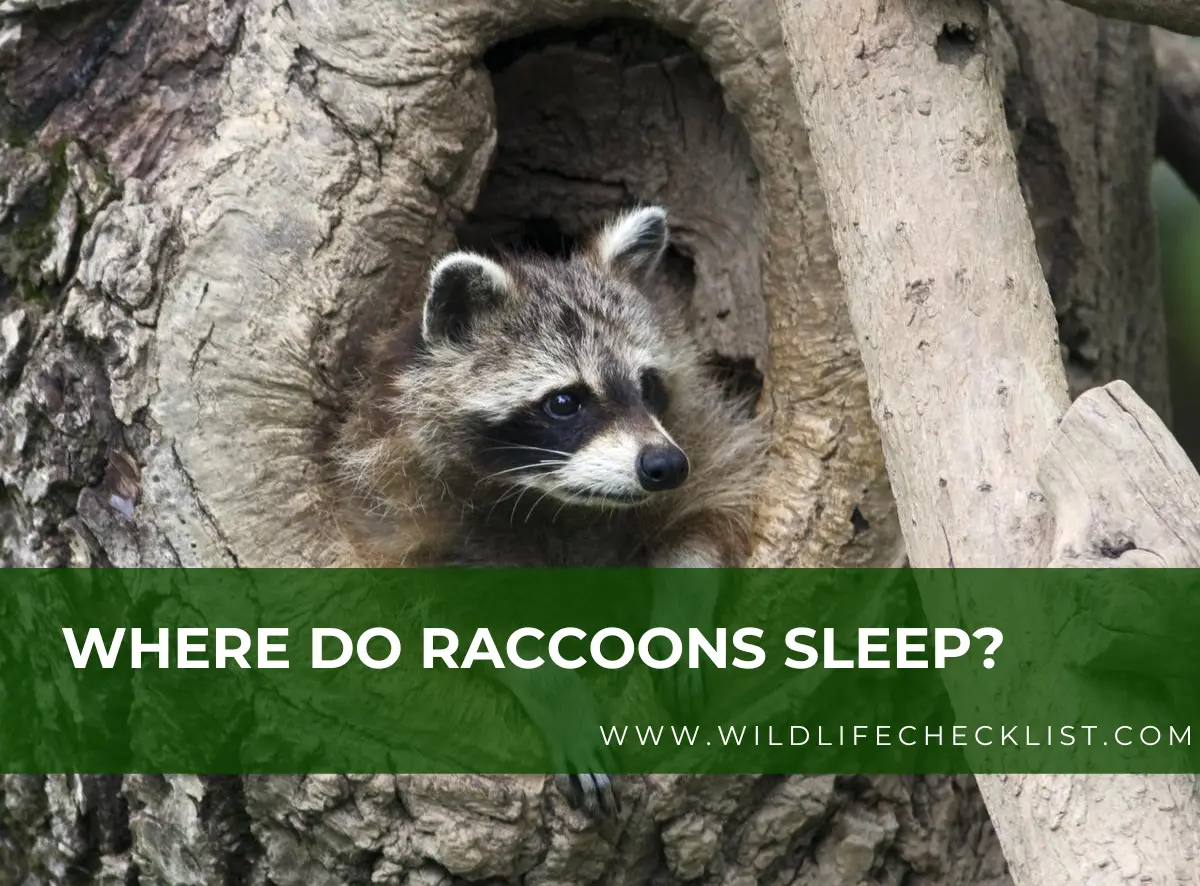Where Do Raccoons Sleep? (Where to Find a Sleeping Raccoon)

Have you ever wondered where those cunning raccoons hide out during the day? If you’ve ever seen these masked assailants in action, you’ve undoubtedly wondered, “Where do raccoons sleep?”
Raccoons have mastered the ability to locate comfortable places to sleep, whether high up in a tree, in your attic, or in a quiet corner of an abandoned building.
Not only will it pique your curiosity, but understanding these sleeping patterns will help you show good neighborly behavior to your raccoon neighbors. Let’s embark on this expedition, solving the mystery of “Where Do Raccoons Sleep,” and developing a newfound admiration for these nocturnal explorers and their crafty sleeping techniques!
Contents
Raccoon Preferences and Habits
The cunning animals, known as raccoons, are incredibly adaptable. They have mastered the knack of surviving in various environments, from dense forests to crowded cities. One of the reasons they are so prevalent in North America is their versatility.
- Raccoons are surprisingly picky when it comes to choosing their sleeping spots. Several factors influence where they choose to sleep. Safety is a crucial concern; raccoons are wise enough to stay away from busy places to protect themselves and their young from harm.
The proximity to supplies of water and food is another crucial element. Raccoons like to eat late at night. Therefore, they frequently make their homes near stable food supplies, such as fruit trees in suburban gardens or garbage cans outside a restaurant.
Raccoons have become quite the urbanites, speaking of cities. They’ve discovered that our homes’ chimneys, attics, and other hidden spaces provide perfect nesting locations. Urban locations are raccoon hotspots because they are often kinder and safer than most natural surroundings.
The key to success for raccoons is the same as for real estate agents: location! Raccoons have developed their sleeping patterns and tastes depending on what provides them with safety, nutrition, and a little bit of solitude, whether they are in the center of a busy metropolis or nestled away in the countryside.
Natural Places to Sleep
These clever animals have created a variety of creative resting spots in the wild, each one catered to their particular need. Here’s a look at where they often take their naps naturally:
- Trees Cavities and Hollows
Raccoons are adept climbers and aren’t afraid to cuddle up in a cozy tree hole. These predator-free natural caves also offer a cozy place for their young kits during the early months.
- Rock Holes and Crevices
Little hiding places in nature! Raccoons looking for shelter from dangerous conditions or potential threats will find protection and insulation in the rock fissures and caves.
- Dens at Ground Level
Raccoons may construct ground-level shelters in dense foliage or underbrush if trees are not possible. They may snooze safely in these secluded locations while still keeping a close check on their surroundings.
- High Grass or Underbrush Nesting
Raccoons are known to construct improvised shelters in tall grass or behind dense undergrowth. Particularly during the nesting season, these patches offer comfort in addition to camouflage.
- Nesting Supplies
Raccoons are experts at reproducing with whatever is available. To create a soft, secure environment for their young, leaves, grass, and other natural materials are stitched together.
Raccoons have a variety of sleeping spots in the wild because of nature’s adaptability, each of which meets their particular needs and the varying seasons. The raccoon equivalent of a five-star hotel suite, these natural settings offer security, comfort, and easy access to food supplies. It serves as a reminder of these wonderful creatures’ adaptability and the wonders of the untamed world.
Where Do Raccoons Sleep?
It turns out that raccoons are more than simply city dwellers; they are essentially urban planners. They’ve gotten good at using the nooks and crevices that metropolitan settings provide to locate inventive resting spots inside our concrete landscapes. Here’s a look at some of their ingenious urban sleeping spots:
- Attics
Attics are raccoons’ favorite living space in metropolitan areas; they may be compared to a posh apartment. These cozy, isolated locations provide protection from the elements and outside disturbance, giving them the perfect place to raise their young.
- Vents and Chimneys
Raccoons love chimneys and pipes because they are cozy, high up, and frequently overlooked. While keeping close to their hunting grounds—our neighborhoods—they provide security.
- Sheds and garages
These are attractive tiny hiding places for raccoons that provide concealment and a potential food source. They could fit between cracks or find a cozy place to call home.
- Unoccupied Buildings
Raccoons have a keen sense of where to live. Raccoons can find shelter in abandoned buildings, especially ones with simple entrances, without having to cope with the commotion of occupied human areas.
Survival and Safety
Getting a secure haven to rest and refuel is just as important to animals as getting food and avoiding danger while still conscious. This entails finding the appropriate resting location, particularly as dusk presents its own set of difficulties for raccoons. Let’s explore the fascinating world of raccoon survival.
The Importance of Secure Sleeping Locations
Consider yourself a raccoon, a mammal that must navigate a hostile environment full of potential predators. It’s not simply a luxury to have a safe place to sleep; it’s a must for survival. These places resemble their sanctuaries, where individuals may unwind without being concerned about dangers.
Raccoons have mastered the ability to choose locations that offer protection from the elements, such as tree hollows or dense vegetation, while also minimizing exposure to predators. A safe sleeping location guarantees they’ll be refreshed, aware, and prepared to take on the difficulties of another night.
Threats and Predators Faced While Sleeping
Life is difficult for raccoons attempting to get some rest. Predators of all kinds are eager to snag a sleeping raccoon at night, from stealthy owls hovering overhead to clever foxes searching for dinner. Raccoons are threatened by curious canines, moving vehicles, and human contact, even in cities.
Raccoons have evolved to stay one step ahead of their predators because they know they are not alone in this world.
How Raccoons Protect Their Sleeping Bodies
Raccoons have lived for a very long time. They have created techniques to reduce the risks while you sleep. They choose areas to sleep that offer natural protection, such as the heights of trees or the security of rock crevices. They choose a location that gives security rather than merely haphazardly seeking a cozy niche.
Raccoons occasionally use the “safety in numbers” strategy. They may sleep in groups, frequently family groupings, with many eyes and ears on the lookout for danger. Some of them even alter their sleep schedule to sleep during the daytime when many predators are less active.
Where Do Raccoons Sleep in The Winter?
It is believed that raccoons sleep more during the winter season. So, where do they sleep during winter? Raccoons are always found in their dens, sleeping and laying low during winter. Their shelters can be found in tree cavities or underground caves, and sometimes, they use chimneys and attics for their shelter.
A raccoon will enter a state of torpor during winter, an alternative to hibernation. In this state, they enter a deep sleep, which helps them reduce their heart rate and temperature for a short period. Because this is not a total hibernation, it helps them come out quickly, look for food, stretch their legs, or escape danger.
How Much do Raccoons Sleep in a Day?
Raccoons can sleep between 6 to 8 hours per day and do sleep till night when they leave their dens to forage for food. It is worth noting that the amount of sleep they have daily depends on factors like the time of the year and other factors.
If a raccoon is searching for a den to sleep, it can reduce the hours it will get to sleep. But raccoons are known to sleep more when it’s during the winter than when it’s in a warmer season.
When do Raccoons Sleep?
Raccoons are night animals, which means they are always active at night, but when do raccoons always sleep? Raccoons sleep during the day and stay up at night to look for food. There are also times you will see raccoons looking for dens to sleep in during the day, and you can see them looking for food in the urban areas during the day.
Majorly, a raccoon sleeps during the day and forages for food at night. One of the things that do help them at night is that they have a black mask around their eyes, which is believed to be instrumental to their night vision.
Do Raccoons Poop Where They Sleep?
Raccoons are known to be clean animals; one thing they do is ensure they wash their food even before eating. Raccoons will always look for a place away from where they eat or sleep if they want to poop.
They always look for a spot known as the “Latrine Site, ” where wildlife animals often defecate and urinate. But raccoons have a weak commitment to the latrine site and can use another spot to ease themselves.
Are Raccoons Sleeping Nearby hazardous to People?
Raccoons normally pose little harm to people, even when they are nearby getting some naps. However, keep in mind that they are wild creatures with certain space requirements. Keep your distance if you see a raccoon sleeping.
It’s like posting a “Do Not Disturb” sign for them. Raccoons are not aggressive animals, but they do have sharp nails and fangs that they may use if they feel attacked or trapped. Allow them to enjoy their sleep in quiet and respect their desire for seclusion.
Conclusion
The intriguing subject of “Where do raccoons sleep?” has been uncovered. We’ve discovered the many locations that raccoons pick for their much-needed repose, ranging from the natural corners of the woods to the unexpected urban sanctuaries.
It’s important to know where raccoons sleep so that we can coexist peacefully with these intelligent animals. We may make deliberate decisions that lessen potential conflicts by respecting their settings and taking into account their requirements.
The next time you see a raccoon, remember that they are beings looking for a secure spot to rest rather than merely evening travelers. Let’s ensure that our activities benefit both their well-being and the well-being of our common planet by being good neighbors to these cloaked wonders.




